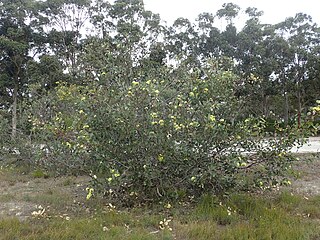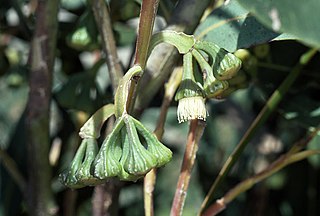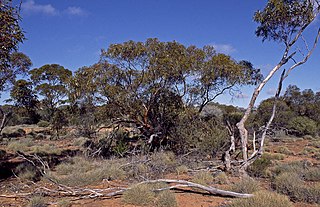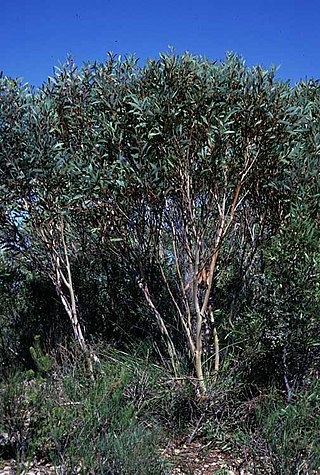
Eucalyptus pleurocarpa, commonly known as tallerack, talyerock or tallerack is a species of mallee that is endemic to the southwest of Western Australia. It has smooth bark, broadly lance-shaped to elliptical, grey or glaucous leaves that are arranged more or less in opposite pairs, flower buds in groups of seven, whitish flowers and glaucous, barrel-shaped fruit. It is easily recognised in the field by its form, large, white, waxy leaves and, when in flower, its stamens clustered in four groups.

Eucalyptus pulverulenta, commonly known as silver-leaved mountain gum, is a species of straggly tree or mallee that is endemic to southern New South Wales. It has smooth bark, egg-shaped, heart-shaped or round, sessile leaves arranged in opposite pairs, flower buds in groups of three, white flowers and cup-shaped to cylindrical fruit.

Eucalyptus grossa, commonly known as coarse-leaved mallee, is a species of mallee or rarely a straggly tree, that is endemic to Western Australia. It has rough, fibrous bark on the trunk and all but the thinnest branches, broadly lance-shaped to egg-shaped adult leaves, flower buds in groups of seven, yellowish green flowers and cup-shaped to cylindrical fruit.

Eucalyptus preissiana, commonly known as bell-fruited mallee, is a species of small tree or shrub that occurs in an area between Albany and Esperance in Western Australia. It has a spreading habit, smooth bark, elliptical to egg-shaped or oblong leaves, flower buds in groups of three, yellow flowers and cup-shaped, conical or bell-shaped fruit.

Eucalyptus drummondii, commonly known as Drummond's gum or Drummond's mallee, is a species of mallee or tree that is endemic to the southwest of Western Australia. It has smooth bark, narrow elliptical to egg-shaped adult leaves, flower buds in groups of seven, white flowers and hemispherical fruit.

Eucalyptus aquilina, commonly known as the Mount Le Grand mallee, is a mallee that is endemic to a small area in the south-west of Western Australia. It has smooth white and grey bark, lance-shaped, often curved leaves, top-shaped or diamond-shaped flower buds, white to cream-coloured flowers and cone-shaped fruit on a down-curved peduncle.

Eucalyptus acies, commonly known as the Woolbernup mallee is a straggly shrub that is endemic to a restricted part of the south-west of Western Australia. It has smooth bark, lance-shaped leaves, club-shaped flower buds with prominent ridges on their sides, creamy white flowers and hemispherical to bell-shaped fruit.

Eucalyptus articulata, also known as the Ponton Creek mallee, is a low, straggly mallee that is endemic to a small area near Kalgoorlie in the Goldfields-Esperance region of Western Australia. It has smooth bark, lance-shaped leaves, flower buds in groups of seven, white flowers and conical fruit.

Eucalyptus × balanites, commonly known as Cadda Road mallee, is a tree or a mallee that is endemic to a small area of the south-west of Western Australia. It has rough, corky or flaky bark, lance-shaped adult leaves, flower buds in groups of eleven, creamy-white flowers and hemispherical to cup-shaped fruit.

Eucalyptus erectifolia, commonly known as Stirling Range mallee, is a species of mallee that is endemic to Western Australia. It has smooth bark, narrow lance-shaped adult leaves, flower buds in groups of between seven and thirteen, white flowers and cup-shaped fruit.

Eucalyptus johnsoniana, commonly known as Johnson's mallee, is a species of mallee that is endemic to Western Australia. It has smooth, greyish brown bark, sometimes with flaky to fibrous brownish bark at the base, lance-shaped adult leaves, flower buds in groups of seven, creamy white flowers and shortened spherical fruit with an unusually small opening.
Eucalyptus leprophloia, commonly known as scaly butt mallee, is a species of mallee that is endemic to a small area in Western Australia. It has rough, fibrous bark on the base of the trunk, smooth bark above, lance-shaped adult leaves, flower buds in groups of seven to eleven, white flowers and cup-shaped to barrel-shaped fruit.

Eucalyptus petrensis, commonly known as limestone mallee, straggly mallee or koodjat, is a species of straggly mallee that is endemic to Western Australia. It has mostly smooth bark, lance-shaped adult leaves, flower buds in groups of between seven and thirteen, creamy white flowers and more or less spherical fruit.
Eucalyptus × phylacis, commonly known as the Meelup mallee, is a species of tree or a robust mallee that is endemic to a small area in the southwest of Western Australia. It has rough, hard and corky bark on the trunk and larger branches, lance-shaped or curved adult leaves, flower buds in groups of eleven, creamy white flowers and hemispherical fruit. It is possibly a hybrid between E. decipiens and E. virginea.

Eucalyptus pluricaulis, commonly known as the purple-leaved mallee, is a species of mallee that is endemic to Western Australia. It has smooth bark, dull bluish green, lance-shaped leaves, flower buds in groups of between nine and fifteen, pale yellow flowers and cylindrical to barrel-shaped fruit.

Eucalyptus suberea, commonly known as Mount Lesueur mallee or cork mallee, is a species of mallee or a small tree that is endemic to a small area on the west coast of Western Australia. It has rough bark on some or all of the trunk, smooth white bark above, lance-shaped adult leaves, flower buds in groups of eleven to twenty or more, white flowers and shortened spherical fruit.

Corymbia ferriticola, commonly known as Pilbara ghost gum, is a species of tree or a mallee that is endemic to Western Australia. It has smooth bark, lance-shaped adult leaves, flower buds in groups of seven, creamy white flowers and shortened spherical to cylindrical fruit.

Eucalyptus crucis is a species of mallee that is endemic to Western Australia. There are three subspecies, commonly known as silver mallee or Southern Cross mallee,, narrow-leaved silver mallee, and Paynes Find mallee,. It has rough bark that is shed in curling flakes, more or less round, glaucous juvenile leaves, egg-shaped intermediate leaves and lance-shaped adult leaves. The type of bark and the proportion of juvenile, intermediate and adult leaves in the crown of mature plants varies with subspecies. The flower buds are arranged in groups of seven in leaf axils, the flowers are whitish to pale yellow and the fruit is a conical to hemispherical capsule.
Eucalyptus cuprea, commonly known as the mallee box, is a species of mallee that is endemic to the west coast of Western Australia. It has rough, flaky bark on the base of its trunk, smooth coppery-coloured bark above, lance-shaped adult leaves, flower buds in groups of seven, creamy white flowers and conical to cup-shaped fruit.
Eucalyptus × missilis, commonly known as bullet bush, is a species of mallee that is endemic to a small area on the south coast of Western Australia. It has smooth bark, egg-shaped to lance-shaped adult leaves, flower buds in groups of between seven and fifteen, pale yellow flowers and cup-shaped to cylindrical fruit. It is thought to be a hybrid between E. cornuta and E. angulosa that occur in the same area.

















